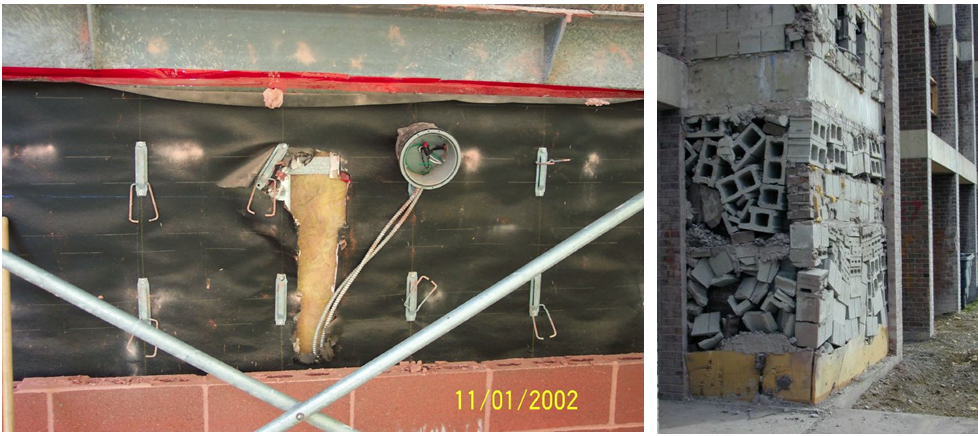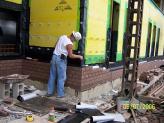What do architects need to know in regards to ensuring that buildings perform as designed?
Designing the Exterior Wall: An Architectural Guide to the Vertical …
Four Barriers For Four Wetting Potentials: How To Design Effective Exterior Walls
What are the four barriers of the four wetting potentials when designing effective exterior walls? They are Air, Water, Heat and Vapor barriers. This is our four-part series. Here, in Part 2 we discuss Water Barrier systems.
Part 1 – Effective Exterior Walls – Air Barrier | Part 3 – Effective Exterior Walls – Vapor Barrier
There are the four wetting potentials affecting exterior walls; Moisture Transport Due To Air Flow (Air Barrier), Liquid Water Ingress (Water Barrier), Dew Point ( Heat Barrier Location), Vapor Migration ( Vapor Barrier).
How Do We Properly Deal With These Four Wetting Potentials?
Good HAMM. HAMM is the 4 barriers needed to protect a building against the effects of weather. These barriers are [H] Heat Barrier, [A] Air Barrier, [M]L Water Barrier ( Liquid Moisture ), [M]V Vapor Barrier ( Gaseous Moisture ). Together, HAMM is the Weather Barrier System.
Good HAMM effectively deals with thermal transfer, wetting and drying potentials:
Heat Barrier: Thermal loss, thermal gain, and bridging. Wetting potential due to a dew point (location)
Air Barrier: Thermal loss and gain. Wetting potential due to moisture transport via air flow.
Water Barrier: Wetting potential due to liquid moisture intrusion into and through the Building Enclosure System.
Vapor Barrier: Wetting potential due to vapor diffusion into and through the Building Enclosure System.
What is a Water Barrier System?
The Water Barrier System resists the intrusion of moisture in its liquid form ( water ) into and through the building enclosure system. Over the history of Building Enclosure System use, water barriers have been: Ineffective due to their inability to resist water penetration. Ineffective due to improper installation. Ineffective due to lack of longevity. If an air barrier is properly designed and installed in a building enclosure system and the air barrier material is also a water barrier, won’t the past deficiencies of water barrier be resolved?
Best use of Water Barrier Systems
Ninety percent of construction litigation is due to water infiltration. So you better get your water barrier right.
The Dew Point Analysis Tool
The Dew Point Analysis Tool is the most widely used design tool in determining the suitability of building enclosure system design for moisture control. “But,” says Len, “Guess what!? It doesn’t work.”
Oak Ridge National Laboratories
“ Out of Date: Dew-Point(Glaser)”
“ The Dew-Point method as detailed in ASHRAE has been a common method to assess the moisture balance of a building component by considering vapor diffusion transport in its interior. However, this method does not allow for the capillary moisture transport in the component. It also doesn’t allow for its sorption capacity. Both of which reduce the risk of damage in case of condensation. Furthermore, since the method only considers steady-state transport under heavily simplified boundary conditions, it cannot reproduce individual short-term events or allow for rain and solar radiation. It is meant to provide a general assessment of the hygrothermal suitability of a component, not to produce a simulation of realistic heat and moisture conditions in a component exposed to the weather prevailing at its individual location.”
Moisture Control In Buildings
Heinz R. Trechsel, Editor, ASTM Manual Series
Chapter 11: Design Tools by Anton TenWolde
Commentary on the Dew Point Analysis, Glaser Diagram and Kieper Diagram“The methods discussed previously have the same severe limitations and should therefore be used with caution. The methods only “predict “ condensation, not moisture damage. Many constructions can sustain limited periods of condensation without significant damage, especially if the temperature are near or below freezing and the material is able to dry quickly. In addition, performance problems such as mold and mildew or paint failure are not necessarily related to surface condensation.
These methods ignore air leakage. If air leakage is present, it tends to dominate moisture transport. Even small amounts of indoor air leaking into the wall (exfiltration ) can more than double the condensation rate during Winter.”
“The methods do not recognize liquid capillary action transport or any transport mechanisms other than diffusion. This tends to result in the underprediction of moisture transfer in materials such as wood in higher moisture contents.
All three methods are steady state and do not recognize the effects of moisture and heat storage. This may be a major drawback in trying to determine the potential for damage in a wall or roof with large storage capacity in a climate with a low drying potential.
All three methods are one dimensional; that is, the effect of corners, holes, or cracks, studs or other thermal bridges cannot be evaluated.”
Is this effective Water Barrier Systems?
Exo-tec has roofing waterproofing products and wall drainage solutions for above- and below-grade waterproofing solutions. These solutions are intended for both pre-concrete and post-concrete pour applications. Our fluid-applied waterproofing and dampproofing products stand up to the toughest weather and job site conditions.


 Len Anastasi has been working in the construction industry for over 30 years in masonry, waterproofing and restoration work.
He currently owns EXO-TEC Manufacturing, Inc., EXO-TEC Solutions, Inc. and EXO-TEC Consulting, Inc.
In his construction and consulting work, he has performed inspections and repairs on over 300 buildings.
Len has given expert testimony in trials and reviews on dozens of legal cases.
He is a member of ASTM’s E 06 Committee, the Boston Society of Architects Building Enclosure Council, Air Barrier Association of America, the Construction Specifications Institute, and the International Concrete Repair Institute.
Book Len for your Next Event!
Len Anastasi has been working in the construction industry for over 30 years in masonry, waterproofing and restoration work.
He currently owns EXO-TEC Manufacturing, Inc., EXO-TEC Solutions, Inc. and EXO-TEC Consulting, Inc.
In his construction and consulting work, he has performed inspections and repairs on over 300 buildings.
Len has given expert testimony in trials and reviews on dozens of legal cases.
He is a member of ASTM’s E 06 Committee, the Boston Society of Architects Building Enclosure Council, Air Barrier Association of America, the Construction Specifications Institute, and the International Concrete Repair Institute.
Book Len for your Next Event! 